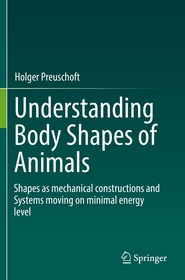
Understanding Body Shapes of Animals
Shapes as mechanical constructions and Systems moving on minimal energy level
-
12% KEDVEZMÉNY?
- A kedvezmény csak az 'Értesítés a kedvenc témákról' hírlevelünk címzettjeinek rendeléseire érvényes.
- Kiadói listaár EUR 192.59
-
79 876 Ft (76 073 Ft + 5% áfa)
Az ár azért becsült, mert a rendelés pillanatában nem lehet pontosan tudni, hogy a beérkezéskor milyen lesz a forint árfolyama az adott termék eredeti devizájához képest. Ha a forint romlana, kissé többet, ha javulna, kissé kevesebbet kell majd fizetnie.
- Kedvezmény(ek) 12% (cc. 9 585 Ft off)
- Kedvezményes ár 70 291 Ft (66 944 Ft + 5% áfa)
Iratkozzon fel most és részesüljön kedvezőbb árainkból!
Feliratkozom
79 876 Ft

Beszerezhetőség
Megrendelésre a kiadó utánnyomja a könyvet. Rendelhető, de a szokásosnál kicsit lassabban érkezik meg.
Why don't you give exact delivery time?
A beszerzés időigényét az eddigi tapasztalatokra alapozva adjuk meg. Azért becsült, mert a terméket külföldről hozzuk be, így a kiadó kiszolgálásának pillanatnyi gyorsaságától is függ. A megadottnál gyorsabb és lassabb szállítás is elképzelhető, de mindent megteszünk, hogy Ön a lehető leghamarabb jusson hozzá a termékhez.
A termék adatai:
- Kiadás sorszáma 1st ed. 2022
- Kiadó Springer International Publishing
- Megjelenés dátuma 2025. július 17.
- Kötetek száma 1 pieces, Book
- ISBN 9783030276706
- Kötéstípus Puhakötés
- Lásd még 9783030276676
- Terjedelem581 oldal
- Méret 235x155 mm
- Nyelv angol
- Illusztrációk XIV, 581 p. 222 illus. Illustrations, black & white 679
Kategóriák
Hosszú leírás:
"
This book discusses how and why animals evolved into particular shapes. The book identifies the physical laws which decide over the evolutionary (selective) value of body shape and morphological characters. Comparing the mechanical necessities with morphological details, the author attempts to understand how evolution works, and which sorts of limitations are set by selection.
The book explains morphological traits in more biomechanical detail without getting lost in physics, or in methods. Most emphasis is placed on the proximate question, namely the identification of the mechanical stresses which must be sustained by the respective body parts, when they move the body or its parts against resistance.
In the first part of the book the focus is on ‘primitive’ animals and later on the emphasis shifts to highly specialized mammals. Readers will learn more about living and fossil animals.A section of the book is dedicated to human evolution but not to produce anotherevolutionary tree, nor to refine a former one, but to contribute to answering the question: “WHY early humans have developed their particular body shape"".
Tartalomjegyzék:
Chapter1: Why this book?.- Chapter2: Head.- Chapter3: Axial skeleton in aquatic animals.- Chapter4: Axial skeleton and muscle arrangement in terrestrial tetrapods.- Chapter5: What have the extremities of “lower tetrapods” in common? And Why?.- Chapter6: Birds.- Chapter7: Land-living mammals.- Chapter8: Primates, the group including humans.- Chapter9: Evolution of hominids.- Chapter10: Summary, Conclusions and Open questions.
Több





